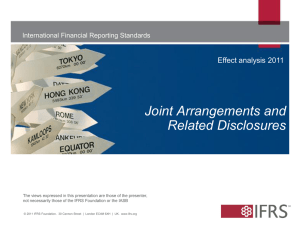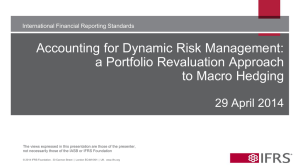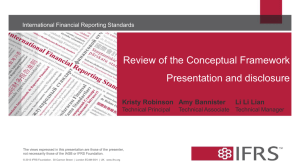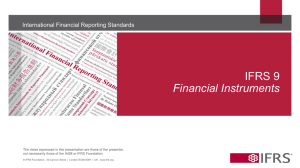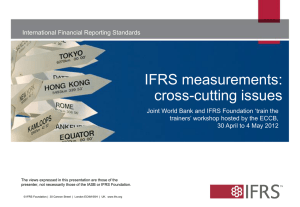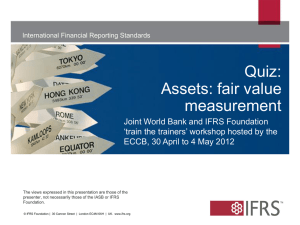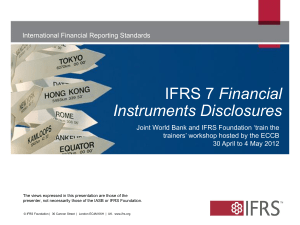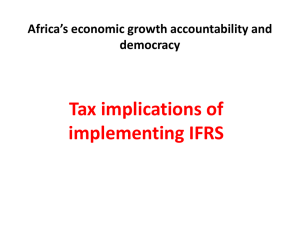Framework
advertisement
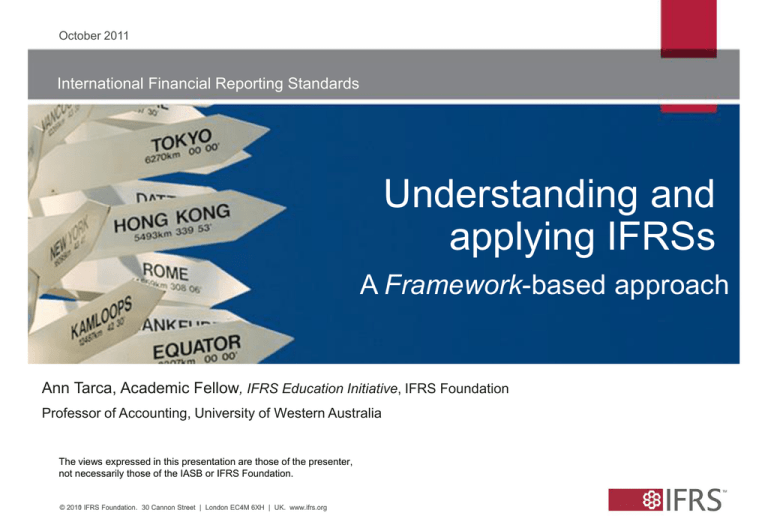
October 2011 International Financial Reporting Standards Understanding and applying IFRSs A Framework-based approach Ann Tarca, Academic Fellow, IFRS Education Initiative, IFRS Foundation Professor of Accounting, University of Western Australia The views expressed in this presentation are those of the presenter, not necessarily those of the IASB or IFRS Foundation. © 2011 2010 IFRS Foundation. 30 Cannon Street | London EC4M 6XH | UK. www.ifrs.org Framework-based understanding… 2 • relates IFRS requirements to the concepts in the Conceptual Framework • reasons why some IFRS requirements do not maximise those concepts (e.g. application of the cost constraint or inherited requirements) Concepts Principles © 2010 IFRS Foundation. 30 Cannon Street | London EC4M 6XH | UK. www.ifrs.org Rules Does the Framework help me understand IFRSs? 3 • Yes, the starting point for understanding all IFRS information is the objective and the concepts that flow logically from that objective: – IASB uses Framework to set IFRSs – Teachers/Trainers use Framework-based teaching to prepare students to make judgements that are necessary to apply IFRSs – Preparers use Framework to make the judgements that are necessary to apply IFRSs – Auditors and regulators assess those judgements – Investors, lenders and others consider those judgements when using IFRS financial information to inform their decisions © 2011 IFRS Foundation. 30 Cannon Street | London EC4M 6XH | UK. www.ifrs.org The IASB’s Conceptual Framework • Framework sets out agreed concepts that underlie IFRS financial reporting – the objective of general purpose financial reporting – qualitative characteristics – elements of financial statements – recognition – measurement – presentation and disclosure Other concepts all flow from the objective © 2011 IFRS Foundation. 30 Cannon Street | London EC4M 6XH | UK. www.ifrs.org 4 Objective of financial reporting 5 “Provide financial information about the reporting entity that is useful to existing and potential investors, lenders and other creditors in making decisions about providing resources to the entity.” Those decisions involve buying, selling or holding equity and debt instruments, and providing or settling loans or other forms of credit © 2011 IFRS Foundation. 30 Cannon Street | London EC4M 6XH | UK. www.ifrs.org Objective of financial reporting • Primary users – provide resources, but cannot demand information – common information needs • Assess the prospects for future net cash inflows – buy, sell, hold – efficient and effective use of resources © 2011 IFRS Foundation. 30 Cannon Street | London EC4M 6XH | UK. www.ifrs.org 6 Fundamental qualitative characteristics • Relevance – predictive value – confirmatory value – materiality, entity-specific • Faithful representation (replaces reliability) – completeness – neutrality – free from error © 2011 IFRS Foundation. 30 Cannon Street | London EC4M 6XH | UK. www.ifrs.org 7 Enhancing qualitative characteristics • Comparability • Verifiability • Timeliness • Understandability © 2011 IFRS Foundation. 30 Cannon Street | London EC4M 6XH | UK. www.ifrs.org 8 Example 1: errors and changes in policies and estimates • Objective • Concepts including qualitative characteristics – faithful representation – comparability • Rules – impracticable exception – specified disclosures © 2011 IFRS Foundation. 30 Cannon Street | London EC4M 6XH | UK. www.ifrs.org 9 Pervasive constraint 10 • Cost – IASB assesses whether the benefits of reporting particular information are likely to justify the costs incurred to provide and use that information. Note: It is consistent with the Framework for an IFRS requirement not to maximise the qualitative characteristics of financial information and other main Framework concepts when the costs of doing so would exceed the benefits. © 2011 IFRS Foundation. 30 Cannon Street | London EC4M 6XH | UK. www.ifrs.org Example 2: Transitional provisions new or amended IFRSs 11 • The concepts = objective and qualitative characteristics, particularly comparability • The principle = retrospective application of new accounting policy • The rule = transitional provisions for new and amended IFRSs – application of the cost constraint © 2010 IFRS Foundation. 30 Cannon Street | London EC4M 6XH | UK. www.ifrs.org Elements Asset 12 Equity = assets less liabilities Income • recognised increase in asset/decrease in liability in • result of past event current reporting period • expected inflow of economic • that result in increased benefits equity except… Liability Expense • present obligation • recognised decrease in • arising from past event asset/increase in liability in current reporting period • expected outflow of economic benefits • that result in decreased equity except… • resource controlled by the entity © 2011 IFRS Foundation. 30 Cannon Street | London EC4M 6XH | UK. www.ifrs.org Financial position 13 The concepts • Information about the nature and amounts of an entity’s economic resources and claims against the reporting entity help users identify the reporting entity’s financial strengths and weaknesses (see ¶OB12– OB14). – help assess entity’s prospects for future cash flows, its liquidity and solvency, its needs for additional financing and how successful it is likely to be in obtaining financing. • Definition of asset, liability and equity (¶4.4) © 2010 IFRS Foundation. 30 Cannon Street | London EC4M 6XH | UK. www.ifrs.org Financial performance The concepts 14 • Financial performance during a period, reflected by changes in its economic resources and claims (other than by obtaining additional resources directly from investors and creditors), is useful in assessing the entity’s past and future ability to generate net cash inflows (see ¶OB18) • Accrual basis of accounting (depicts the effects of transactions and other events and circumstances on a reporting entity’s economic resources and claims in the periods in which those effects occur (see ¶OB17) © 2010 IFRS Foundation. 30 Cannon Street | London EC4M 6XH | UK. www.ifrs.org Example 3 Biological asset in agricultural activity 15 • The concepts: see the previous slide • The principle: A gain or loss arising from a change in fair value less costs to sell of a biological asset shall be included in profit or loss for the period (IAS 41.26) • The limited exception: inability at initial recognition to measure fair value reliably then cost-depreciationimpairment model (IAS 41.27) © 2010 IFRS Foundation. 30 Cannon Street | London EC4M 6XH | UK. www.ifrs.org Classification and Recognition • Class examples and discussion © 2011 IFRS Foundation. 30 Cannon Street | London EC4M 6XH | UK. www.ifrs.org 16 Measurement concepts 17 • Measurement is the process of determining monetary amounts at which elements are recognised and carried. (¶4.54) • To a large extent, financial reports are based on estimates, judgements and models rather than exact depictions. The Framework establishes the concepts that underlie those estimates, judgements and models (¶OB11) • IASB guided by objective and qualitative characteristics when specifying measurements. © 2010 IFRS Foundation. 30 Cannon Street | London EC4M 6XH | UK. www.ifrs.org Measurement section of Framework 18 • Measurement section of Framework is weak―only lists some measurement methods used in practice: – historical cost: cash paid or fair value of consideration given – current cost: cash that would be paid if acquired now – realisable (settlement) value: cash that could be obtained by selling the asset now – present value: present discounted value of future net cash inflows that the item is expected to generate – market value: listed but not described in Framework. For fair value see IFRS 13 Fair Value Measurements © 2010 IFRS Foundation. 30 Cannon Street | London EC4M 6XH | UK. www.ifrs.org Example 4 Allocating depreciation: concepts 19 • Information about an entity’s financial performance in a period, reflected by changes in economic resources (egg PPE) is useful in assessing the entity’s past and future ability to generate net cash inflows (see ¶OB18) • Expenses are decreases in economic benefits during an accounting period in the form of depletions of assets… (¶4.25) • Depreciation represents the consumption of the assets service potential in the period. – land with an indefinite useful life is not depreciated because its service potential does not reduce with time © 2010 IFRS Foundation. 30 Cannon Street | London EC4M 6XH | UK. www.ifrs.org Example 4 Allocating depreciation: principle 20 • Depreciation is the systematic allocation of the depreciable amount of an asset over its useful life (IAS16.6) – essentially a cost allocation technique (IAS16.BC29) © 2010 IFRS Foundation. 30 Cannon Street | London EC4M 6XH | UK. www.ifrs.org Example 4: allocating depreciation: application guidance (1) 21 • Systematic allocation (application guidance): – Depreciation method must closely reflects the pattern in which the asset’s future economic benefits are expected to be consumed by the entity. – Unit of measure for depreciation is different from that for an item of PPE. By depreciating significant parts of an item of PPE separately, depreciation more faithfully represents the consumption of the assets service potential. (IAS16.BC26) © 2010 IFRS Foundation. 30 Cannon Street | London EC4M 6XH | UK. www.ifrs.org Example 4: allocating depreciation: application guidance (2) 22 • Depreciable amount = – cost model: historical cost less residual value – revaluation model: fair value less residual value • Residual value = – amount that the entity would currently obtained from disposal of asset (less estimated disposal costs) if the asset were already of the age and in the condition expected at the end of its useful life © 2010 IFRS Foundation. 30 Cannon Street | London EC4M 6XH | UK. www.ifrs.org Example 4: allocating depreciation: application guidance (3) 23 • Useful life (entity specific) = – the period over which the asset is expected to be available for use by the entity; or – the number of production or similar units expected to be obtained from the asset by the entity. • Consequently, depreciation continues when idle (if useful life = period) • However, depreciation ceases when classified as held for sale because IFRS 5 measurement is essentially a process of valuation, rather than allocation (IFRS5.BC29) © 2010 IFRS Foundation. 30 Cannon Street | London EC4M 6XH | UK. www.ifrs.org Recognition 24 • The concept: recognise element (egg asset) when – probable that benefits will flow to/from the entity – has cost or value that can measured reliably (see ¶4.38) • The principle – recognise elements (egg asset) when they satisfy the definition and recognition criteria (see ¶ IAS1.28) • Applying the principle (see individual IFRSs) What does probable mean? © 2010 IFRS Foundation. 30 Cannon Street | London EC4M 6XH | UK. www.ifrs.org Derecognition of assets 25 • Derecognition of an asset refers to when an asset previously recognised by an entity is removed from the entity’s statement of financial position – derecognition requirements are specified at the standards level. – derecognition does not necessarily occur when the asset no longer satisfies the conditions specified for its initial recognition (i.e. derecognition does not necessarily coincide with the loss of control of the asset ) • IASB guided by objective, qualitative characteristics and elements © 2010 IFRS Foundation. 30 Cannon Street | London EC4M 6XH | UK. www.ifrs.org Presentation and disclosure 26 • Presentation: financial statements portray financial effects of transactions and events by: – grouping into broad classes (the elements, egg asset) – sub-classify elements (egg assets sub-classified by their nature or function in the business) • IAS 1 – application of IFRSs with additional disclosures when necessary results in a fair presentation (faithful representation of transactions, events and conditions) – do not offset assets & liabilities or income & expenses • IASB guided by objective and qualitative characteristics © 2010 IFRS Foundation. 30 Cannon Street | London EC4M 6XH | UK. www.ifrs.org Presentation and disclosure • Subclassification • Class examples and discussion © 2010 IFRS Foundation. 30 Cannon Street | London EC4M 6XH | UK. www.ifrs.org 27 Framework-based understanding provides… 28 • a cohesive understanding of IFRSs – Framework facilitates consistent and logical formulation of IFRSs • a basis for judgement in applying IFRSs – Framework established the concepts that underlie the estimates, judgements and models on which IFRS financial statements are based • a basis for continuously updating IFRS knowledge and IFRS competencies © 2010 IFRS Foundation. 30 Cannon Street | London EC4M 6XH | UK. www.ifrs.org Framework’s role in applying IFRSs 29 Does the Framework help me apply IFRSs? • Yes, Framework is in IAS 8 hierarchy (see next slide) – Preparers use the Framework to make the judgements that are necessary to apply IFRSs – Auditors and regulators assess those judgements – Investors, lenders and others consider those judgements when using IFRS financial information to inform their decisions © 2011 IFRS Foundation. 30 Cannon Street | London EC4M 6XH | UK. www.ifrs.org If no specific IFRS requirement 30 • Use judgement to – develop a policy that results in relevant information that faithfully represents (i.e. complete, neutral and error free) – Hierarchy: 1st IFRS dealing with similar and related issue 2nd Framework definitions, recognition crit. etc Can also in parallel refer to GAAPs with similar Framework © 2011 IFRS Foundation. 30 Cannon Street | London EC4M 6XH | UK. www.ifrs.org In other words, if no IFRS requirement… 31 Framework-based approach would ask: • What is the economics of the phenomenon (egg transaction or event)? • What relevant information using the accrual basis of accounting faithfully present that economic phenomenon to inform decisions of investors and lenders (potential and existing)? • Is there anything in IFRSs that prevents me from providing that information? © 2011 IFRS Foundation. 30 Cannon Street | London EC4M 6XH | UK. www.ifrs.org Example 5: non-cash distribution 32 Before IFRIC 17, entity distributes non-cash asset (e.g. land or shares in another entity) whose fair value = CU1 million. Carrying amount of asset = cost = CU1K • Economics = reduce owners’ claims against the entity by distributing to them an asset worth CU1m • Relevant information for investors and lenders that faithfully represents the economics: – investors received CU1 million refund of capital. – value of assets available to meet lenders’ claims reduced by CU1 million. © 2011 IFRS Foundation. 30 Cannon Street | London EC4M 6XH | UK. www.ifrs.org Example 5: non-cash distribution 33 Before IFRIC 17… (continued) • Does IFRSs prevent providing that information? No. Therefore: – recognise CU999K income (previously unrecognised increase in the value of the asset derecognised). – recognise CU1 million distribution to owners. © 2011 IFRS Foundation. 30 Cannon Street | London EC4M 6XH | UK. www.ifrs.org Example 6: share-based payment 34 Before IFRS 2, entity pays employee in own shares. Par value of shares issued = CU1K. Fair value of services provided = CU1 million = fair value of shares. • Economics = entity paid employees CU1 million for services. Employees invested CU1 million in entity. • Relevant information for investors and lenders that faithfully represents the economics: – CU1 million services received = staff cost. – CU1 million invested = increased owner equity. • Does IFRSs prevent providing that information? No. Therefore, recognise CU1 million expense and recognise CU1 million increase in owners’ equity. © 2011 IFRS Foundation. 30 Cannon Street | London EC4M 6XH | UK. www.ifrs.org Common misunderstandings The Framework does not… include a matching concept include prudence/conservatism concept include an element other comprehensive income (or a concept for OCI) mention management intent or business model © 2010 IFRS Foundation. 30 Cannon Street | London EC4M 6XH | UK. www.ifrs.org 35 Clarification—the Framework includes accrual basis of accounting— recognise elements when satisfy definition and recognition criteria neutrality concept only the following elements— asset, liability, equity, income and expense Common misunderstandings continued Misunderstanding Principles are necessarily less rigorous than rules There are few judgements and estimates in cost-based measurements © 2010 IFRS Foundation. 30 Cannon Street | London EC4M 6XH | UK. www.ifrs.org 36 Clarification Rules are the tools of financial engineers Inventory, egg allocate joint costs and production overheads PP&E, egg costs to dismantle/restore site, useful life, residual value, depreciation method Provisions, egg uncertain timing and amount of expected future cash flows Support for Framework-based teaching 37 • IFRS Foundation education initiative works with others to support Framework-based teaching – create awareness – develop material (starting with PPE) – hold workshops (in 2011: Basseterre and Vienna with World Bank; Bucharest, Denver, George and Venice with IAAER; and Rio with BNDES) – encourage those certifying accountants to examine their students’ ability to make the judgements that are necessary to apply IFRSs © 2010 IFRS Foundation. 30 Cannon Street | London EC4M 6XH | UK. www.ifrs.org Questions or comments? Expressions of individual views by members of the IASB and their staff are encouraged. The views expressed in this presentation are those of the presenter. Official positions of the IASB on accounting matters are determined only after extensive due process and deliberation. © 2011 IFRS Foundation. 30 Cannon Street | London EC4M 6XH | UK. www.ifrs.org 38 Class activity • Case Study © 2011 IFRS Foundation. 30 Cannon Street | London EC4M 6XH | UK. www.ifrs.org 39
